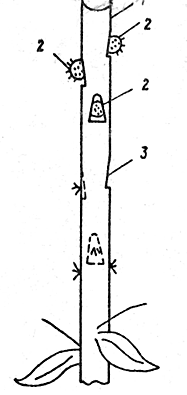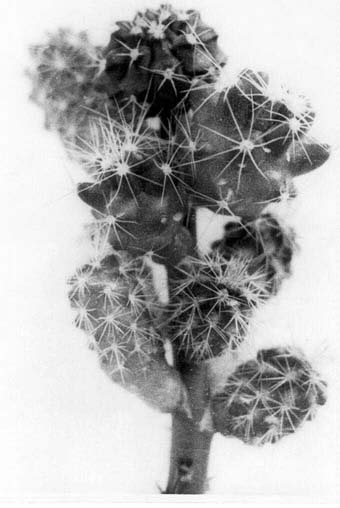CACTI ON VERTICAL STOCKS
By Irina V. Ovchinnikova, Ukraine
Seven years ago I took interest in grafting cacti on Pereskiopsis. Once I had an idea of grafting a seedling onto the place of an areole. First I grafted 8 seedlings onto a Pereskiopsis which I put horizontally on the soil. The lower areoles rooted, and I grafted seedlings onto the upper ones. The scions survived and developed so dynamically that surpassed their congeners grafted in a usual way.
 |
| Photo 1. |
I was not satisfied with horizontal grafts though they are very convenient – you should just put a cut seedling on the horizontal cut and that's it. As I lacked spare room which is typical for any big collection of cacti I wanted to try vertical grafting.
I chose 10 specimens of Pereskiopsis 20-25 cm high and grafted 20-30 seedlings on them. I usually keep leaves at the lower part of Pereskiopsis, 5-10 cm up from the lowest leaf. The rest of the stem is for grafts. The process demands a lot of patience and skill. It is not difficult to graft 3-4 seedlings as they have enough cell sap which glues them to the stock and does not dry during the time of grafting. But when you graft 20-30 seedlings the upper ones dry out and fall off even if you place the Pereskiopsis under the cover with high humidity after grafting each of the seedlings. No fixtures work here. I just cut the leaves of Pereskiopsis lenghtwise and dip the cut of the scion in the cell sap. The sap from the leaf of Pereskiopsis is identical to the sap of its stem. That's why the scion is never rejected.
There are also difficulties in cutting areoles. It is not difficult to cut off a prominent areole, it is more difficult to do it in the lower part of the stem. It merges with the stem, so I do a cutting as shown at the picture 1.
 |
| Photo 2. |
After grafting I place the Pereskiopsis to a humid greenhouse. Four to seven days are enough for the scion and stock to grow together. Then I keep the plants as usual.
Pereskiopsis has such a drawback as growing into the graft. If you graft seedlings onto areoles it does not happen. Besides the "pushing" ability of an areole is so strong that even the seedlings with damaged growing point give offsets from each of their own areoles. Seedlings take rather well even at the lowest areoles though this part is usually so lignified that a usual graft should be excluded.
In two months the seedlings grow 1-1.2 cm high and become crowded. You may cut off every second one and keep the rest to grow up to 3-4 cm.
When you graft vertically you skip 2 prickings out of seedlings, save room and time. I grafted about 30 species of cacti and I never observed any rejection or incompatibility.
Material by V. Boxer, Angarsk.





